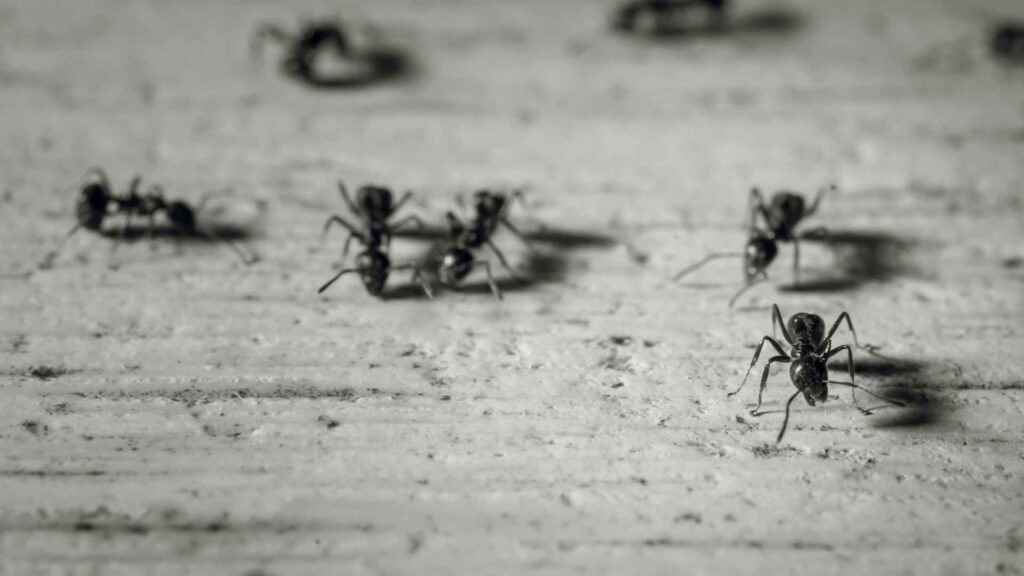Table Of Content
ToggleAs a pest control expert, I frequently encounter homeowners asking how to get rid of ant colonies in their yards.
Those tiny invaders can quickly disrupt your outdoor enjoyment. This guide will equip you with the knowledge and strategies to eliminate ant colonies and reclaim your pest-free haven.
Ant colonies are complex social structures with a distinct hierarchy. Worker ants tirelessly forage for food, while the queen focuses solely on egg-laying to ensure colony survival.
Several ant species can set up camp in your yard, and it’s crucial to identify them for effective control. Some ant species, like carpenter ants, can even damage your property. Beneficial ant varieties, however, help with aeration and prey on other harmful insects.
Understanding the type of species you’re dealing with is crucial to get rid of ants. Here are some common ant species found in yards:
Ants are attracted to readily available food sources, moisture, and suitable nesting sites. Sweet spills, pet food remnants, and overflowing compost bins can all become a smorgasbord for them.
Additionally, ant pheromones, a chemical communication system, guide them to establish new colonies.
Eliminate Ants Effortlessly: Contact Our Pest Control Services!

Tired of ants marching across your kitchen counter or raiding your outdoor picnics?
Here are several effective, non-toxic approaches to help you manage ant populations in your yard and potentially even eliminate the colony:
Ants are tiny but determined explorers. Help keep them out by:
For a more direct approach:
Important Note: When using any DIY method, safety is paramount. Always follow recommended safety instructions for any products you use and wear gloves if necessary. For large infestations or if these methods prove ineffective, consider consulting a professional pest control service.
Turn Your Home Ant-Free: Expert Help is Just a Phone Call Away!

While non-toxic methods are ideal, sometimes stubborn ant infestations require a stronger approach. Insecticides can be effective in these situations, but prioritize safety when using them:
Safety First
Different ant species respond to different insecticides. To choose the right weapon, try to identify the type of ant you’re dealing with (common household ants include odorous house ants, pavement ants, and carpenter ants).
Some stores may carry ant identification kits or you can consult a professional pest control service.
Insecticides come in various forms to suit your needs:
Apply the chosen insecticide according to the manufacturer’s recommendations. This typically involves targeting ant trails, the nest entrance, and other areas with high ant activity. Remember, more isn’t always better. Over-application can be ineffective and harmful to the environment.
A Final Note: Chemical solutions should only be used as a last resort, and with extreme caution. If you’re uncomfortable using insecticides yourself, or if the infestation seems overwhelming, consider consulting a professional pest control service.

If DIY methods fail to control the ant problem, consider seeking help from a professional pest control service.
No More Ants: Let Our Skilled Team Safeguard Your Space!
Once you’ve eliminated the ant colony, take proactive steps to prevent their return:
By following these strategies, you can create an ant-free oasis in your yard and enjoy your outdoor space without pesky invaders.

As a pest control expert, I’ve equipped you with the knowledge and tools to tackle ant colonies in your yard. Remember, the key lies in identifying the ant species, implementing effective control measures, and maintaining a proactive approach.
By following the strategies outlined in this guide, you can reclaim your outdoor haven and enjoy a pest-free space for relaxation and enjoyment. Don’t hesitate to take action if you see signs of ants – a little effort now can prevent a bigger problem later. Now get out there and create that ant-free oasis!
To permanently get rid of an ant colony, combine direct nest removal techniques, such as boiling water or diatomaceous earth, with long-term deterrents like regular yard maintenance and sealing entry points into your home.
There are so many ant colonies in your yard likely due to the presence of favorable conditions such as moisture, available food sources, and shelter, which create ideal breeding grounds for ants.
To get rid of an ants nest in the ground, you can pour boiling water directly into the nest, apply an insecticidal bait around the area, or use a targeted pesticide that reaches the queen.
To get rid of a field ant infestation, focus on eliminating food sources, applying granular insecticides across the affected area, and disrupting their nesting sites with regular lawn care and strategic landscaping.
References:
https://www.ars.usda.gov/arsuserfiles/60360510/publications/Klotz_and_Williams-1996(M-3020).pdf
https://dph.illinois.gov/topics-services/environmental-health-protection/structural-pest-control/ants.html
Your trusted pest control experts in Southern California. Keeping your neighborhood pest-free!